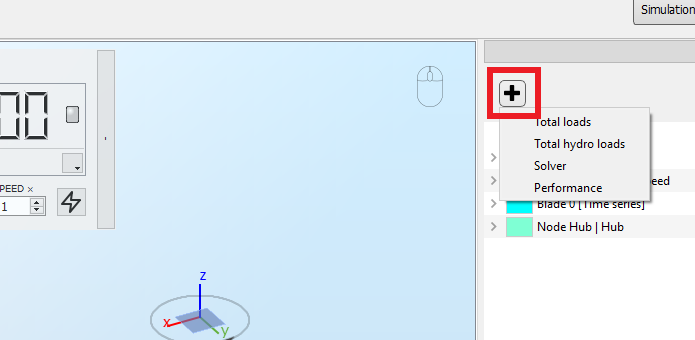Solver sensor
The
Solver
sensor provides information about the numerical solver in Ashes and can be added from the
Special sensors
button as shown in the figure below

The
Solver
sensor is meant to help you if you run into non-convergence issues while running nonlinear simulations. Make sure you have a look at the theory manual, in the
Time domain simulation
section where the algorithms to solve for the dynamic equations in Ashes are explained. Concepts like the total
Internal energy
of the system or the
Residual energy
for a given time step are relevant for assessing the quality of the results of a nonlinear simulation, but we are still trying to find the best way to make the link between the two in Ashes. If you have any issues, doubts or feedback, please let us know at
support@simis.io
.
The
Solver
sensor provides the following fields:
| Field | Unit | Description |
| Loads with inf magnitude | - | To be removed in the next versions of Ashes |
| Loads greater than MAXLOADWARNING | Load list | List of loads whose magnitude is greater than 10 12 . This can indicate whether loads have become unphysical, which can be useful in case of non-convergence issue. |
| Loads, high curvature | Load list | List of loads for which the second derivative of the magnitude is larger than 10 8 . This can indicate whether loads have become unphysical, which can be useful in case of non-convergence issue. |
| Iteration count | - | Number of interations necessary to obtain convergence of the Newton-Raphson algorithm in the last time step. If the number of iteration is too large, the simulation will not converge (see Displacement and load residual tolerances were not reached ) |
| Last converged criterion | int | This output takes a value of 1 if the last iteration fulfilled the Relative convergence criteria and 2 if it fulfilled an Absolute criteria (see Time domain simulation ). |
| Total kinetic energy | MJ | Total kinetic energy in the system, used to evaluate the convergence criteria (see Time domain simulation ) |
| Total strain energy | MJ | Total strain energy in the system, used to evaluate the convergence criteria (see Time domain simulation ) |
| Kinetic + strain energy | MJ | The sum of the total kinetic energy and the total strain energy. This is the internal energy of the system. |
| Total work done by loads | MJ | |
| Internal energy - external work | MJ | |
| Energy residual (translational) | - | Translational residual energy as defined in Time domain simulation . For each time step, in a nonlinear simulation, the residual energy is the difference between the exact solution and the approximate solution obtained through the Newton-Raphson iterations. For the time-step to converge and the results to be accurate, the residual energy must be as small as possible (in the order of 10 -20 times the total energy) |
| Energy residual (rotational) | - | Rotational residual energy, as defined in Time domain simulation . For each time step, in a nonlinear simulation, the residual energy is the difference between the exact solution and the approximate solution obtained through the Newton-Raphson iterations. For the time-step to converge and the results to be accurate, the residual energy must be as small as possible (in the order of 10 -20 times the total energy) |
| Accumulated absolute energy error (translational) | J | The sum over time of the translational residual energy |
| Accumulated absolute energy error (rotational) | J | The sum over time of the translational rotational energy |